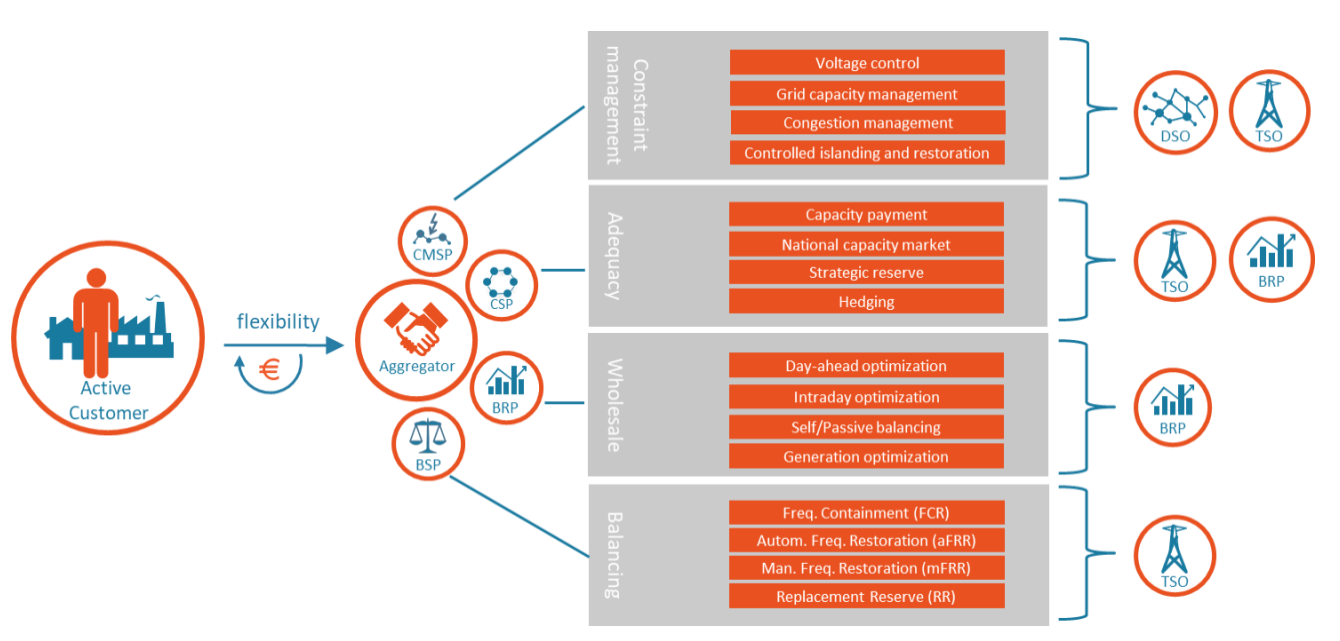What is flexibility?
Flexibility refers to the ability to adjust consumption, storage, or production patterns to meet system needs and reduce system costs. In the context of flexibility, there are two types: implicit and explicit flexibility. While explicit flexibility involves the user voluntarily providing flexibility, which a third-party service provider then activates, implicit flexibility involves the user deciding whether to activate their flexibility at the time of need based on a predetermined price. Implicit flexibility is more suitable for expected or recurring needs, while explicit flexibility can be used for unexpected needs.
 Implicit flexibility (USEF ENERGY)
Implicit flexibility (USEF ENERGY)
 explicit flexibility (USEF ENERGY)
explicit flexibility (USEF ENERGY)
In a flexible electricity system, various sources of flexibility can be utilized through demand response, energy storage, and production adjustments. A user can offer their flexibility directly to a requester or through a third-party service provider or aggregator. Flexibility can be utilized for various purposes and by various requesters, including net management, supply security, wholesale electricity markets, and network balancing. Some applications of flexibility, such as balancing or electricity markets, are global and affect the entire electricity network or control zone. Meanwhile, other local applications, such as net management, apply flexibility to a specific part of the electricity network.
Why do we need flexibility?
The transition to low-carbon energy sources, such as solar and wind energy, will both require large-scale production, such as off-shore wind energy, and small or decentralized production, such as solar panels. Additionally, most of those energy sources will be intermittent and difficult to predict.
Furthermore, a significant portion of our current energy consumption will be electrified, and the electricity demand is expected to double by 2050.
The main benefit of a smart and flexible energy grid is that it reduces the cost of investments that are necessary for the increased production capacity to meet the expected increase in peak load. This, in turn, will have an effect on the prices that end consumers have to pay. Apart from that, it also offers more insight and control for the end user through access to smart technologies and services. Flexibility facilitates the integration of local, decentralized solutions for low-carbon energy, and it is a crucial requirement for the energy transition around the world.
Flexibility Plan 2025
To answer the need for increased flexibility on the energy grid, the Flemish government introduced the Flexibility Plan 2025, which builds upon the existing energy regulations in the region, including the policy framework on flexibility and anchor points that have already been established. This plan requires having the necessary measurement equipment to deliver flexibility. Electronic meters are available on the medium and high voltage grid, but until recently, households and small professional users did not have access to digital meters at low voltage levels. As a result, the Flemish government decided to roll out digital meters for all customers, with 80% of the meters installed by December 31st, 2024, and the remaining 20% by July 1st, 2029.
A more in-depth look into the goals and proposed actions of the Flexibility Plan 2025 will be handled in a later article.
Conclusion
At Trilations, we are convinced that the evolution of flexibility services will be a crucial part of the electrification of our energy use and the energy transition at large. We make sure to stay updated on both regulatory and technological developments in these fields, and we are ready to assist our clients with these upcoming transitions.
If you want to know more about how we are already involved in flexibility, be sure to reach out!





